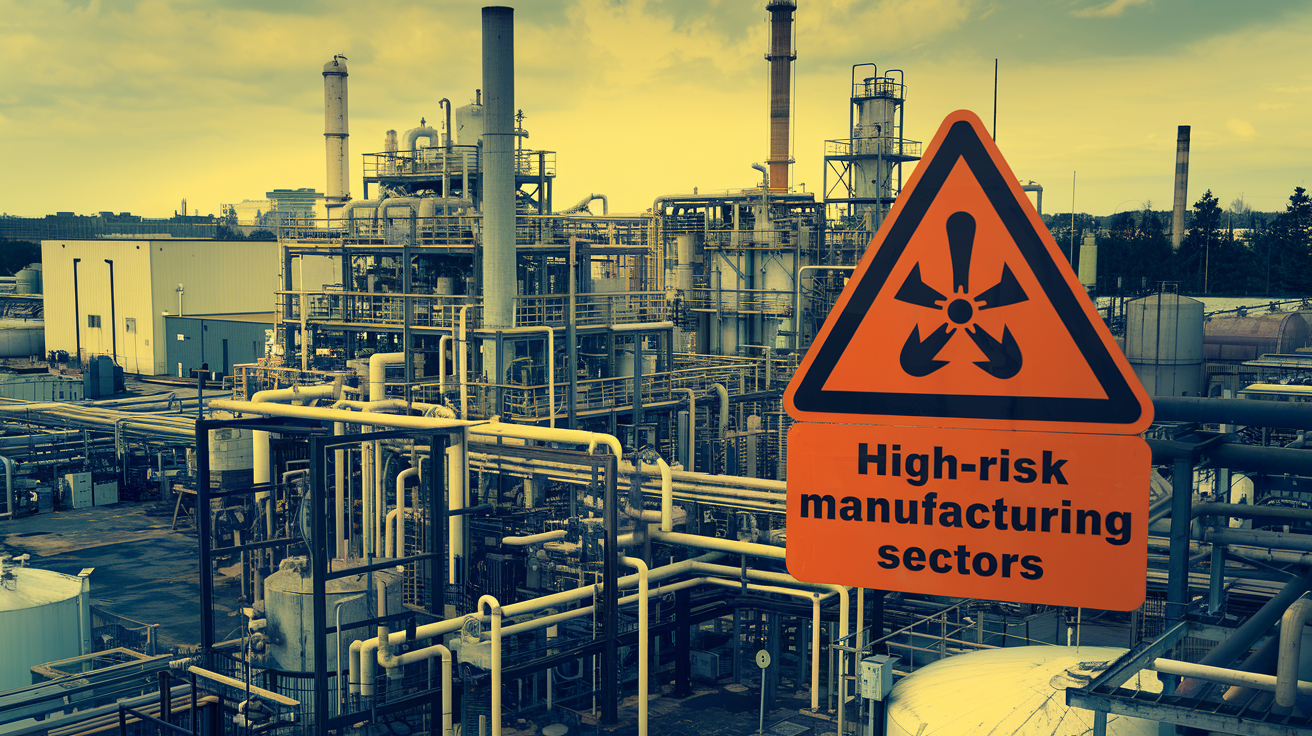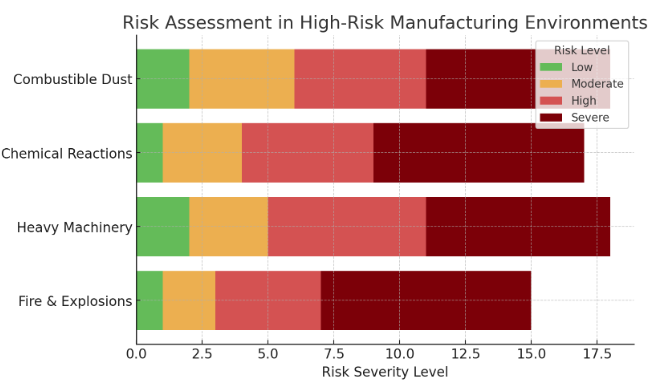
Adapting Fire Safety Measures for High-Risk Manufacturing Sectors
Unfortunately, a one-size-fits-all approach wont cut it when it comes to fire safety. This is especially true for high-risk manufacturing sectors.
Each & every environment presents its own set of hazards, demanding tailored solutions that go beyond basic compliance.
You’ll need to explore advanced technologies, thorough fire risk assessments, and robust training programs to truly make a difference.
With that being said, you may wonder what measures you can take to guarantee both safety and efficiency?
The answers might surprise you, and will help you redefine your fire safety strategy.
Understanding High-Risk Manufacturing Environments
High-risk manufacturing environments are defined by their potential for hazardous incidents, often involving flammable materials, heavy machinery, or complex chemical processes.
In these settings, you’re constantly exposed to risks that require your full attention. Understanding these environments is important for fire safety and key to preventing accidents.

The presence of highly flammable substances such as solvents and gases can dramatically increase the risk of fire and explosions, and the improper use of heavy machinery adds yet another layer of danger which can lead to serious injuries.
In addition to this, complex chemical processes may involve reactions that could become volatile if not properly managed. and the accumulation of combustible dust can heighten the risk of fire hazards in any industrial factory setting.
To maintain a safe workplace, you must familiarize yourself with the hazards present in your environment. This involves identifying potential ignition sources, recognizing the properties of materials you’re working with, and understanding the operation of machinery.
Regular training and fire safety drills can help you and your colleagues stay prepared for emergencies.
Regulatory Compliance and Standards
In any manufacturing environment, understanding regulatory compliance and safety standards is absolutely essential for fire prevention. Fire safety regulations in the UK are governed by The Regulatory Reform (Fire Safety) Order 2005 Learn more, which outlines legal requirements for workplaces to assess and mitigate fire risks.
Strict adherence to HSE regulations is necessary for any workplace dealing with combustible materials or high-risk industrial processes.
If your workplace involves dangerous substances, you must also adhere to the Dangerous Substances and Explosive Atmospheres Regulations (DSEAR) 2002, which sets specific safety measures for handling and storing these materials.
To maintain compliance, you should:
- Conduct regular fire risk assessments to identify and manage hazards.
- Ensure proper fire safety training for all employees, making them aware of emergency procedures.
- Follow British Standards (BS 5839, BS 5306, etc.) for fire alarm systems, extinguishers, and other fire protection measures.
- Keep detailed records of fire safety checks, training, and maintenance to demonstrate compliance.
Failure to comply with fire safety laws can result in fines, legal action, or business closures. By staying up to date with UK regulations and embedding fire safety into workplace culture, you can better protect your workforce and reduce risks.
How to Conduct a Fire Risk Assessment
A fire risk assessment helps identify potential hazards, reduce risks, and ensure a safer workplace. By following a structured approach, you can take the right steps to prevent fires and protect your team.

Start by putting together a team with different skills and knowledge. This way, you get a broader perspective on potential risks in your workplace. Working together helps identify dangers that might otherwise be missed.
Next, walk through and carefully inspect your factory. Look for anything that could start a fire, materials that might catch fire easily and any obstacles that could block escape routes. Write and document everything down, these notes will be important for future reviews.
Use a simple and effective method like the “5-step process”:
-
Identify fire hazards.
-
Assess the risks.
-
Determine who could be harmed.
-
Put safety measures in place.
-
Review and update the assessment regularly.
You should also stay up to date with industry regulations and safety standards. Following the rules isn’t just about avoiding fines, it’s about keeping your workplace safe. Review your fire risk assessments regularly to stay compliant and reduce risks over time.
Advancing Fire Safety with Modern Technology
Identifying fire hazards is only the first step. To truly enhance safety in manufacturing environments, it’s important that you integrate modern fire prevention technologies that detect and control risks before they escalate.
Start by looking into implementing advanced fire detection systems if you haven’t done so already. These systems use smart sensors to identify smoke, heat, or gas leaks early, sending real-time alerts to your safety team. Acting fast can mean the difference between a minor incident and a major disaster.
Is your factory properly equipped for fire safety?
Contact us today on FREEPHONE 0800 999 11 25 for expert advice on fire prevention and protection solutions.
Another key innovation is automated fire suppression systems. These activate instantly when a fire is detected, releasing fire-suppressing agents without the need for human intervention.
Its also a good idea to use flame-resistant materials in machinery and infrastructure which adds another layer of defense. These materials slow down fire spread giving workers more time to respond and evacuate if necessary.
Regular maintenance of fire prevention equipment is just as important as having it in place. Routine inspections ensure all systems function properly and comply with safety regulations.
Employee Training and Awareness
Creating a culture of safety hinges on thorough employee training and awareness programs. You need to guarantee that every employee understands fire safety protocols, the importance of compliance, and their individual responsibilities.
Regular training can equip your team with the knowledge to recognize hazards and respond effectively in emergencies.
Fire drills and training sessions not only boost emergency response skills but also reinforce a culture of safety.
Explore the chart below to learn more about the fire safety training courses we offer:
| Type of Training Course | Benefit of Training | Frequency of Training | Link |
|---|---|---|---|
| Online Fire Safety Training (Zoom Courses) | Improves knowledge of fire safety procedures and emergency response | Ongoing/Regular | Online Fire Safety Training |
| Fire Awareness & Evac Chair Training Course | Teaches fire safety awareness and use of evacuation chairs | As needed for staff | Fire Awareness & Evac Chair Training |
| Evac Chair Training | Teaches the proper use of evacuation chairs in emergencies | As required | Evac Chair Training |
| General Fire Safety Services | Comprehensive fire safety solutions for workplaces | Ongoing/Regular | Fire Safety Services |
| Fire Awareness Training | Teaches essential fire awareness and safety protocols | Ongoing/Regular | Fire Awareness Training |
| Fire Marshal Training | Prepares staff to act as fire marshals and lead evacuation efforts | Ongoing/Regular | Fire Marshal Training |
| Fire Alarm Responder Training | Teaches how to respond effectively to fire alarm situations | As needed for staff | Fire Alarm Responder Training |
| Fire Extinguisher Training | Provides hands-on training on the correct use of fire extinguishers | Ongoing/Regular | Fire Extinguisher Training |
Emergency Response Planning Strategies
A solid emergency response plan is important for minimizing the impact of fire incidents in high-risk manufacturing environments.
You need to develop a thorough strategy that includes clear communication, defined roles, and regular drills. This guarantees that everyone knows what to do in case of a fire, reducing panic and confusion.
To create an effective emergency response plan, consider the following strategies:
Establish a clear chain of command
Assign specific roles to employees during an emergency to streamline the response process.
Conduct regular training sessions
Regularly practice Fire drills to familiarize employees with evacuation routes and safety procedures reinforcing their preparedness.
Create a communication plan
Ensure there’s a reliable method to alert all employees, whether it’s through alarms, text messages, or loudspeakers.
Confirm evacuation procedures
Confirm that emergency evacuation procedures are well-documented and easily accessible to all staff
Conclusion
To sum it up, prioritizing fire safety in high-risk manufacturing sectors is essential for protecting lives and property.
By adapting measures that include thorough risk assessments, advanced detection technologies, and regular employee training, you create a safer work environment.
If you have any questions or would like to talk to us about fire safety at your factory, give us a call on 0800 999 11 25 or drop us a message
My Fire Safety. Co-Space, 25 Town Square,
Stevenage, SG1 1BP.
Related Fire Safety Training Courses:
Fire Extinguisher Training
Regular Refresher Training
Fire Marshal Training
Fire Alarm Training

Sorry, the comment form is closed at this time.